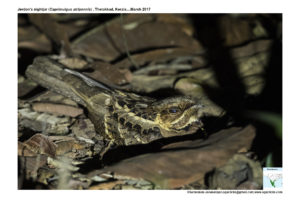
Jerdon’sNightjar Caprimulgus atripennis
Etymology:
- Caprimulgus : Latin word capra – goat; mulgere –to milk . The nightjar were assumed to drink goats milk and injure the goats
- Atripennis : Latin wordater- black; pennis-winged
Distribution in India: Resident in peninsular India.
Description:Size of 27-28 cm. They are sexually dimorphic. The crown is greyish-brown, central feathers boldly but sparsely spotted or streaked blackish-brown; rest of upperparts greyish-brown tinged rufous; nuchal collar rufous, often ill-defined; lesser coverts dark brown speckled rufous, rest of wing-coverts greyish-brown, speckled and spotted buff; scapulars blackish-brown, with pale tawny bar across middle of each feather; underparts brownish speckled buff, cinnamon and rufous-buff, becoming buff barred brown on belly and flanks. The male has white spot on four outermost primaries and broad white tips to two outermost tail feathers. The female has buff wing spots and buff or buffish-white tips to two outermost tail feathers, Iris brown, bill dark brown, legs and feet dark brown.
Habitat: It is found in forest, woods and forested country: evergreen forest, moist deciduous forest, dry forest, mixed bamboo forest and second-growth forest; also coffee estates and wooded suburban areas; from sea-level to 2000 m.
Food Habits: It eats moths, helipterums, flying ants, grasshoppers, locusts, cockroaches, small wasps, termites and other insects. It is most active, and mostly feed, near dawn and dusk (crepuscular – active during the twilight). At dusk, they often fly around livestock to feed on insects swarming around the animals. At night, they like to take advantage of insects swarming around street lamps or other artificial light sources. They are keeping their bills wide open as they fly through clouds of small insects. Nightjars may also forage under the canopy by flying from favored perches catching insects at foliage. Larger insects are usually taken back to their favored feeding perches. While holding the insects in their bills, it keeps the head upright, shake and swallow the prey whole, or they may break the insects apart before eating. Insects may also be taken from the ground or foliage.
Breeding Habits: They breed in March-July in India.They have no nest, eggs laid usually on sandy ground, often close to or beneath shrub or bush. They lay a clutch of 2 eggs . The incubation period is 16-19 days, commenced with last egg done by female alone. The male sometimes taking turns close to dusk and dawn.The chicks are born semi-precocial. The brooding bird, covering them closely with its camouflage plumage, is their best protection. The chicks can crawl away from the nest soon after hatching and hide among leaves when alarmed